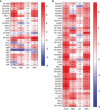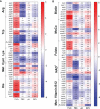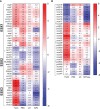Commonalities of Mycobacterium tuberculosis Transcriptomes in Response to Defined Persisting Macrophage Stresses
- PMID: 35844560
- PMCID: PMC9283954
- DOI: 10.3389/fimmu.2022.909904
Commonalities of Mycobacterium tuberculosis Transcriptomes in Response to Defined Persisting Macrophage Stresses
Abstract
As the goal of a bacterium is to become bacteria, evolution has imposed continued selections for gene expression. The intracellular pathogen Mycobacterium tuberculosis, the causative agent of tuberculosis, has adopted a fine-tuned response to survive its host's methods to aggressively eradicate invaders. The development of microarrays and later RNA sequencing has led to a better understanding of biological processes controlling the relationship between host and pathogens. In this study, RNA-seq was performed to detail the transcriptomes of M. tuberculosis grown in various conditions related to stresses endured by M. tuberculosis during host infection and to delineate a general stress response incurring during persisting macrophage stresses. M. tuberculosis was subjected to long-term growth, nutrient starvation, hypoxic and acidic environments. The commonalities between these stresses point to M. tuberculosis maneuvering to exploit propionate metabolism for lipid synthesis or to withstand propionate toxicity whilst in the intracellular environment. While nearly all stresses led to a general shutdown of most biological processes, up-regulation of pathways involved in the synthesis of amino acids, cofactors, and lipids were observed only in hypoxic M. tuberculosis. This data reveals genes and gene cohorts that are specifically or exclusively induced during all of these persisting stresses. Such knowledge could be used to design novel drug targets or to define possible M. tuberculosis vulnerabilities for vaccine development. Furthermore, the disruption of specific functions from this gene set will enhance our understanding of the evolutionary forces that have caused the tubercle bacillus to be a highly successful pathogen.
Keywords: RNA-seq; dormancy; hypoxia; pH; starvation; tuberculosis.
Copyright © 2022 Vilchèze, Yan, Casey, Hingley-Wilson, Ettwiller and Jacobs.
Conflict of interest statement
BY and LE are employees of New England Biolabs, a US company that sells research reagents (such as RNA reagents and library preparation kits) to the scientific community. The remaining authors declare that the research was conducted in the absence of any commercial or financial relationships that could be construed as a potential conflict of interest.
Figures







Similar articles
-
Responses of Mycobacterium tuberculosis hemoglobin promoters to in vitro and in vivo growth conditions.Appl Environ Microbiol. 2008 Jun;74(11):3512-22. doi: 10.1128/AEM.02663-07. Epub 2008 Apr 4. Appl Environ Microbiol. 2008. PMID: 18390674 Free PMC article.
-
Integration of Metabolomics and Transcriptomics Reveals a Complex Diet of Mycobacterium tuberculosis during Early Macrophage Infection.mSystems. 2017 Aug 22;2(4):e00057-17. doi: 10.1128/mSystems.00057-17. eCollection 2017 Jul-Aug. mSystems. 2017. PMID: 28845460 Free PMC article.
-
Mycobacterium tuberculosis and the macrophage: maintaining a balance.Cell Host Microbe. 2008 Jun 12;3(6):399-407. doi: 10.1016/j.chom.2008.05.006. Cell Host Microbe. 2008. PMID: 18541216 Review.
-
Transcriptional Profiling of Mycobacterium tuberculosis Exposed to In Vitro Lysosomal Stress.Infect Immun. 2016 Aug 19;84(9):2505-23. doi: 10.1128/IAI.00072-16. Print 2016 Sep. Infect Immun. 2016. PMID: 27324481 Free PMC article.
-
Macrophage defense mechanisms against intracellular bacteria.Immunol Rev. 2015 Mar;264(1):182-203. doi: 10.1111/imr.12266. Immunol Rev. 2015. PMID: 25703560 Free PMC article. Review.
Cited by
-
Prominent transcriptomic changes in Mycobacterium intracellulare under acidic and oxidative stress.BMC Genomics. 2024 Apr 17;25(1):376. doi: 10.1186/s12864-024-10292-4. BMC Genomics. 2024. PMID: 38632539 Free PMC article.
-
Phosphoglucomutase A-mediated metabolic adaptation is essential for antibiotic and disease persistence in Mycobacterium tuberculosis.mSystems. 2025 Jul 22;10(7):e0042025. doi: 10.1128/msystems.00420-25. Epub 2025 Jun 30. mSystems. 2025. PMID: 40586596 Free PMC article.
-
Small RNA MTS1338 Configures a Stress Resistance Signature in Mycobacterium tuberculosis.Int J Mol Sci. 2023 Apr 27;24(9):7928. doi: 10.3390/ijms24097928. Int J Mol Sci. 2023. PMID: 37175635 Free PMC article.
-
An Arm-to-Disarm Strategy to Overcome Phenotypic AMR in Mycobacterium tuberculosis.bioRxiv [Preprint]. 2024 Jan 2:2023.03.23.533925. doi: 10.1101/2023.03.23.533925. bioRxiv. 2024. PMID: 38260651 Free PMC article. Preprint.
-
The functional response of human monocyte-derived macrophages to serum amyloid A and Mycobacterium tuberculosis infection.Front Immunol. 2023 Sep 15;14:1238132. doi: 10.3389/fimmu.2023.1238132. eCollection 2023. Front Immunol. 2023. PMID: 37781389 Free PMC article.
References
Publication types
MeSH terms
Substances
Grants and funding
LinkOut - more resources
Full Text Sources
Molecular Biology Databases
Research Materials

